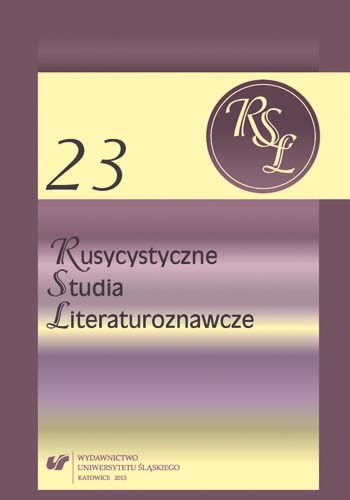Przestrzeń artystyczna dzieł Fiodora Dostojewskiego (na wybranym materiale). Między wcielonym piekłem a rajem
An artistic space of Fyodor Dostoyevsky’s works (on a selected material). Between an incarnated hell and the paradise
Author(s): Mirosława Michalska-SuchanekSubject(s): Literary Texts
Published by: Wydawnictwo Uniwersytetu Śląskiego
Keywords: Dostoyevsky, space, Golden age, Lorrain, dream
Summary/Abstract: The background of the majority of events in Dostoyevsky is marked with the evil. The pictures of vast spaces, nature, water, and heaven are practically absent from his works while the world presented is filled with an urban landscape. The space dazzles us with the sin and gives birth to the sin pushing the characters onto self-annihilation. However, people miss the world that the sense of which is given by such superior values as the Good, Truth and Virtue. An individual, submerged in a spiritual chaos, dreaming about a harmonious and happy world, his/her Arcadia is reflected in Dostoyevsky’s works by the visions of the land eternal bliss.The writer paid special attention to the idea of the “Golden Age”. He interpreted it on his own, being inspired by a well-known drawing, namely Claude Lorrain’s "Akis and Galatea". The pictures connected with the idea of the “Golden Age” are outlined by Dostoyevsky in "The Devils" first of all, or, to be more specific, in a chapter "At Tichon’s" (1871), "The adolescent" (1875), "A dream of a ridiculous man" (1877) and a small draft entitled "The golden age in your pocket" (1876). The visions, usually appearing in dreams, show a paradise lost , a beautiful, harmonious and peaceful world based on man’s harmony with nature. And it is here that the writer, an eulogist of a dark and hostile town shows the space in a totally different tonality. He outlines the state of bliss, a wonderful place, and a land of constant happiness. The two spaces, spaciously marked, reflecting two different worlds, a “real” and “wishful” one (desires, dreams), determine an ideological-cognitive order defining a valuing interpretation of the world presented, constituting, at the same time, an axiological projection of Russian antagonisms in the second half of the 19th century.
Journal: Rusycystyczne Studia Literaturoznawcze
- Issue Year: 2013
- Issue No: 23
- Page Range: 23-37
- Page Count: 15
- Language: Polish

